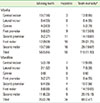1. Albandar JM, Brown LJ, Loe H. Clinical features of early-onset periodontitis. J Am Dent Assoc. 1997; 128:1393–1399.

2. Tonetti MS, Mombelli A. Early-onset periodontitis. Ann Periodontol. 1999; 4:39–53.

3. Ranney RR. Classification of periodontal diseases. Periodontol 2000. 1993; 2:13–25.

4. Hansen BF, Gjermo P, Bergwitz-Larsen KR. Periodontal bone loss in 15-year-old Norwegians. J Clin Periodontol. 1984; 11:125–131.

5. Armitage GC. Development of a classification system for periodontal diseases and conditions. Ann Periodontol. 1999; 4:1–6.

6. Meng H, Xu L, Li Q, Han J, Zhao Y. Determinants of host susceptibility in aggressive periodontitis. Periodontol 2000. 2007; 43:133–159.

7. Leknes KN, Lie T, Selvig KA. Root grooves: a risk factor in periodontal attachment loss. J Periodontol. 1994; 65:859–863.

8. Hou GL, Tsai CC, Huang JS. Relationship between molar root fusion and localized periodontitis. J Periodontol. 1997; 68:313–319.

9. Dunlap RM, Gher ME. Root surface measurements of the mandibular first molar. J Periodontol. 1985; 56:234–238.

10. Gher ME, Vernino AR. Root morphology: clinical significance in pathogenesis and treatment of periodontal disease. J Am Dent Assoc. 1980; 101:627–633.

11. Ross IF, Evanchik PA. Root fusion in molars: incidence and sex linkage. J Periodontol. 1981; 52:663–667.

12. Kim SJ. A study on root morphology of anterior and premolars in Korean generalized aggressive periodontitis patients [dissertation]. Gwangju: Chonnam National University;2009.
13. Löe H. The gingival index, the plaque index and the retention index systems. J Periodontol. 1967; 38:610–616.

14. McGuire MK, Nunn ME. Prognosis versus actual outcome. II. The effectiveness of clinical parameters in developing an accurate prognosis. J Periodontol. 1996; 67:658–665.
15. Karen FN, Takei HH. Determination of prognosis. In : Newman MG, Takei HT, Klokkevold PR, Carranza FA, editors. Carranza's clinical periodontology. 11st ed. St. Louis: Saunder Elsevier;2012. p. 373–383.
16. Picolos DK, Lerche-Sehm J, Abron A, Fine JB, Papapanou PN. Infection patterns in chronic and aggressive periodontitis. J Clin Periodontol. 2005; 32:1055–1061.

17. Mombelli A, Casagni F, Madianos PN. Can presence or absence of periodontal pathogens distinguish between subjects with chronic and aggressive periodontitis? A systematic review. J Clin Periodontol. 2002; 29:Suppl 3. 10–21.

18. Page RC, Offenbacher S, Schroeder HE, Seymour GJ, Kornman KS. Advances in the pathogenesis of periodontitis: summary of developments, clinical implications and future directions. Periodontol 2000. 1997; 14:216–248.

19. Albandar JM, Tinoco EM. Global epidemiology of periodontal diseases in children and young persons. Periodontol 2000. 2002; 29:153–176.

20. Kronauer E, Borsa G, Lang NP. Prevalence of incipient juvenile periodontitis at age 16 years in Switzerland. J Clin Periodontol. 1986; 13:103–108.

21. Kowashi Y. Prevalence of juvenile periodontitis among students at Nagasaki University. Adv Dent Res. 1988; 2:395–396.

22. Wang ZL, Qu XQ, Yang SH, Li XY. Prevalence study of juvenile periodontitis. J Modern Stomatol. 1990; 4:171–172.
23. Cho CM, You HK, Jeong SN. The clinical assessment of aggressive periodontitis patients. J Periodontal Implant Sci. 2011; 41:143–148.

24. Van der Velden U, Abbas F, Armand S, Loos BG, Timmerman MF, Van der Weijden GA, et al. Java project on periodontal diseases. The natural development of periodontitis: risk factors, risk predictors and risk determinants. J Clin Periodontol. 2006; 33:540–548.

25. Baer PN. The case for periodontosis as a clinical entity. J Periodontol. 1971; 42:516–520.

26. Hormand J, Frandsen A. Juvenile periodontitis: localization of bone loss in relation to age, sex, and teeth. J Clin Periodontol. 1979; 6:407–416.

27. Albandar JM, Rams TE. Risk factors for periodontitis in children and young persons. Periodontol 2000. 2002; 29:207–222.

28. Choi BK, Hong KS, Chung CH, Lim SB. A study of distribution, prevalence and relationship of the localized periodontitis of first and second molar root fusion. J Korean Acad Periodontol. 2006; 36:503–513.

29. Ryu SH, Heo SR, Lee SJ, Chang MT, Kim HS. Distribution, prevalence and sex linkage of molar root fusion. J Korean Acad Periodontol. 2002; 32:61–68.

30. Hou GL, Tsai CC. The morphology of root fusion in Chinese adults (I): grades, types, location and distribution. J Clin Periodontol. 1994; 21:260–264.








 PDF
PDF ePub
ePub Citation
Citation Print
Print












 XML Download
XML Download